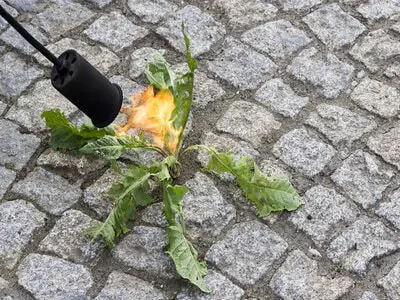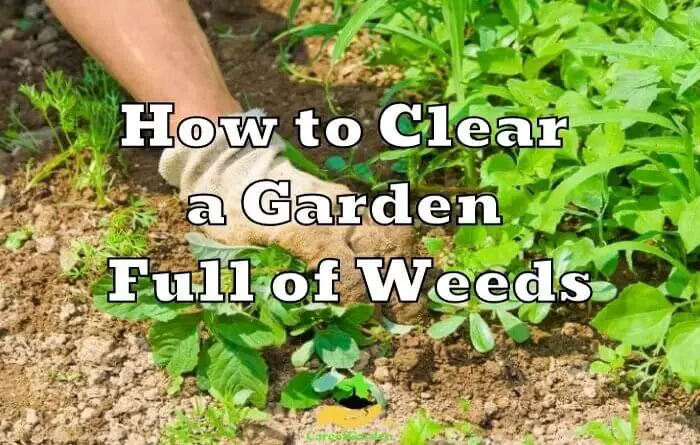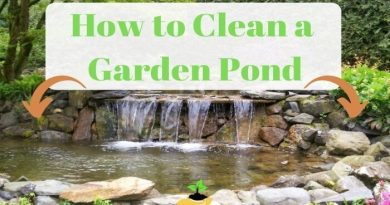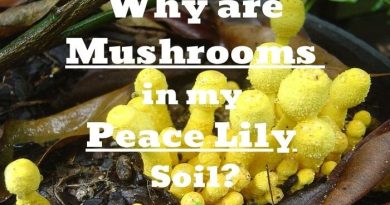How to Clear a Garden Full of Weeds [13 Proven Methods]
Before trying to understand how to clear a garden full of weeds, it is advisable to clarify what can be determining factors for their appearance. In reality, the reason is quite simple: weeds in the garden tend to appear when the turf is weak and “stressed” due to incorrect maintenance, poor or insufficient irrigation or even the use of fertilizers unsuitable for the type of soil present.
The weeds are undesirable plants that steal nutrients, water and light from the sun your garden plants, and there are several strategies to get rid of them and to reduce their negative impact.
Weeds that coexist with cultivated plants in the country, vegetable garden or in the garden reduce the yield and quality of fruits, berries and vegetables grown. Dealing with this unwanted vegetation is unpleasant, but necessary.
In this article we will find out how to get rid of weeds in the garden and what methods of weed control do gardeners use!
| Methods | How to Clear a Garden Full of Weeds |
|---|---|
| 1.Mechanical | Digging Weeding Depletion Mulching |
| 2. Chemical | Heat Boiling Water |
| 3.Thermical | Vinegar Salt Herbicides |
| Type of Weeds | How to Clear Weeds |
|---|---|
| 1. Annual weeds | Annual species (such as wild geranium or sow thistle) have a one-year vegetative cycle that ends during the seed maturation stage. After releasing their seeds and securing their offspring, these weeds will simply wither and die. |
| 2. Perennial weeds | Cutting these weeds at the base will have no effect here, since they have a deep root system that allows them to multiply without sexual reproduction (this is called vegetative propagation). To kill a perennial weed, it is therefore essential to remove the aerial part and the root in its entirety. |
How to Clear a Garden Full of Weeds
1. Mechanical method
The main way to clear a garden full of weeds is mechanical. It is not so much about weeding after planting as about removing old roots. This is where the laying of any flower garden begins: the soil is prepared (dug up), the sod is removed on the sod area – that is, the soil layer is removed, where the bulk of the intertwined roots is located. It is better to dig it in two stages – to raise the soil in large layers before winter, and to dig it up more finely in the spring, breaking clods.
At this stage, it is worthwhile to sort out the soil literally by hand, removing the remaining roots of the weeds. Try to choose even the smallest roots – they can germinate in whole thickets of weeds.
For this reason, supporters of natural agriculture do not favor digging, especially with the use of technical means. Indeed, the cultivator can break the roots into small pieces, which, nevertheless, retain the ability to germinate.
To avoid this, it is better to carry out the initial digging by hand, choosing the roots, and use a pitchfork for this, and not a shovel.
1.1 Digging

This rather laborious, but extremely effective method helps to remove weeds, which are difficult to get rid of in other ways: wheatgrass, dandelion, willow, sour cherry, etc.
Digging is performed on an area free of plantings, as a rule, in the fall, after harvesting. When digging up a vegetable garden, it is better to use a pitchfork instead of a shovel. This way, you will not damage the roots of weeds, which will completely end up on the surface of the soil.
After the completion of the work, all plant residues must be removed from the site and destroyed.
1.2 Weeding
We usually have to weed the garden beds several times per season. You need to start in the spring, when the first cultivated seedlings appear, and with them unwanted neighbors in the form of weeds.
If weeds are left intact, after a short time they will prevail in that garden area. It is important to prevent weeds from blooming, otherwise the fight against them will become more difficult. For weeding, you can use a variety of tools – hoes, hoes, flat cutters, root removers, etc.
It will not work to get rid of weeds by 100% in this way, but by removing the upper part of the plant, you slow down its growth and development, since the grass it will take some time to recover. The culture grown during this time will have time to get stronger.
Freezing . If, after completing the harvest, you dig up the soil and remove the rhizomes from the garden, small fragments of grass, roots, and weed seeds, as a rule, remain on the surface of the earth. All this perishes at the onset of the first frost. This method of weed control is called freezing.
1.3 Depletion
Depletion is understood as the regular pruning of the vegetative parts of weeds (stems, leaves, roots), which leads to an increase in the consumption of nutrients for new plant shoots.
That is, the gardener cuts the germinating parts of the grass until the roots run out of vitality and the plant dies. The method allows you to effectively fight root-sprouting weeds – thistle, pack, bitterness.
1.4 Plowing
The so-called plowing helps to get rid of wheatgrass – grinding with various tools the underground parts of the plant at the main depth of the root system, followed by deep plowing of the segments (awl) into the soil.
To destroy the weed, in this case, surface cross-cultivation of the soil is performed using a disc harrow or a plow with a plowing depth of 10–12 cm. This allows you to grind the plant roots into fragments 10–20 cm long.
In 10–12 days after disking, deep plowing of the soil is carried out , destroying young shoots that have sprouted from the crushed root system.
| Type of Weeds | Plants |
|---|---|
| Root weeds | Hogweed, common plantain, brunelle / brownelle, real sweet clover, cinquefoil, daisies, groundgrass, sorrel, hornwort, ragwort, small sorrel, tuberous buttercup, dandelion, common plantain, ribwort, horsetail, yarrow, vetches |
| Seed weeds | Field mustard, speedwell, goose foot, garden scoop herb, common ragwort, common piglet, hederich, shepherd’s purse, burdock cabbage, thistle, melde, kale, bird knotweed, chickweed, wild carrot, bindweed |
| Weeds crawling above ground | Common horn clover, gundermann, creeping buttercup, wood sorrel, white clover |
Common weeds and how to eliminate them from the garden
| Weed | How to clear from garden (treatment) |
|---|---|
| 1. Plantain | If there are only a few small plants, you can pull them out by hand. Make sure to remove all roots, as even tiny bits will allow a new plant to grow. You can also eliminate them using a ready-to-use herbicide. |
| 2. Poison ivy | If you choose to rip it off, it’s important to always wear heavy rubber gloves and eye protection. You can also spray it with a herbicide when it is actively growing in late spring or early summer. Note that you should never burn it, as it may produce urushiol, a substance that causes severe rashes. |
| 3. Creeping buttercup | Digging the soil to eliminate the whole plant with its runners. |
| 4. Shepherd’s purse | It must be rooted out by performing a methodical weeding . Weed as soon as possible because the shepherd’s purse forms and sheds seeds several times a year. |
| 5. Dandelion | If you are removing them by hand, it is important to remove all of the roots. You can use a preemergence herbicide before the seeds germinate in early spring. If the seeds have already germinated, then you can opt for a ready-to-use herbicide for spot treatment. |
| 6. Quackgrass | Cover the soil in open spaces or dig out the roots 2 to 3 times, one month apart. |
| 7. Field bindweed | Regularly cut the aerial parts to weaken the roots . Cover the ground in open ground. |
| 8. Crabgrass | Applying a layer of mulch to your flower bed will help prevent its presence. You can pull it out at the start of the season, when its roots are shallow. |
| 9. Stinging Nettle | They can be cut with a brush cutter . Then use a pitchfork to loosen the soil and pull the roots out of the weed to make sure they don’t grow back. |
2. Mulching
One of the most famous ways to clear a garden full of weeds is mulching. Mulch keeps the soil moist and cool by depriving weeds of sunlight. A variety of materials are suitable for use as mulch.
This can be humus, compost, peat, pine bark, as well as cut grass, straw, hay, fallen leaves, paper, or, for example, the shells of nuts or eggs. When choosing mulch, certain rules should be followed.
So, pine bark or peat can increase the acidity of the soil, and this is not suitable for all cultivated plants. In addition, some types of mulch may contain weed seeds (for example, in humus, peat, or unripe compost).
You can check the compost for weeds in the spring, for this it is watered with water and covered with foil.
Non-woven material is suitable for mulching: biological – bark, needle haystack, husks, or mineral – stone chips of various fractions. Choose its size for the planted plants.
Use small crumbs in flower beds, and larger pebbles or oakat for trees or shrubs. Remember that minerals from weeds last longer than biological ones.
But they also crumble over time and mix with the soil. This is also worth considering when choosing a mulching material for weeds.
2.1 Cover the ground with tar paper or black non-woven cloth.
The essence of this method is simple: weeds, like other plants, need light. If there is no light they die.
It is more convenient to use roofing paper – it is dense, it will not be blown away by the wind. But this is chemistry. The black non-woven fabric is environmentally friendly, but it is quite thin – it will have to be securely fixed on the soil surface, for example, pressed with boards or bricks.
However, you can use other materials at hand – plywood, cardboard, pieces of iron.
The view of the area covered with opaque material is very unsightly, and it must be kept in this form for the whole season. But on the other hand, the method is very effective even against perennial weeds.
2.2 Sow green manure to clear a garden full of weeds
This technique is especially useful in the vegetable garden or for a bed overgrown with weeds. We weed, then we level, we rake the garden and we sow a green manure.
From the end of June, you can sow phacelia, mustard, buckwheat or spring vetch that you will cut two to three months later.
In the fall, you will sow rye or vetch, which you will cut in the spring. Sown in summer, buckwheat will be cut in November.
2.3. Lay out a black tarp to clear a garden full of weeds

We use this technique mainly when we redo a plank of the vegetable garden or a bed, both very overgrown with weeds.
Weed as best you can, but not necessarily thoroughly, and cover the ground with an opaque plastic tarpaulin, an old carpet or several layers of cardboard covered with compost or 30 cm of dead leaves, for one, even two, full seasons.
The toughest weeds will exhaust themselves by themselves seeking in vain for light. The cardboard and compost method has the advantage of enriching the soil (cardboard boxes disappear in one season, recycled into humus by earthworms).
Does your Kalanchoe have yellow leaves? Don’t worry I have prepared for you a helpful guide about the reasons why Kalanchoe leaves turn yellow and how to prevent it!
3.Thermic method
3.1 Clear a Garden Full of Weeds with Heat

Either with gas or voltage: thermal devices are guided slowly over the weeds, which they heat up in the joints, but also in the bed, with up to 1,000 degrees Celsius. No cell structure survives, the weeds die.
The heat shock does not reach the roots, however, so that the plants often sprout again after one to two weeks. Nevertheless, it is a convenient, time-saving and the only method on paved surfaces besides joint scratches, which, however, has to be used more often.
By the way, boiling water has the same effect and goes a little deeper than the heat shock.
Burning out . Solving the problem of how to destroy weeds on the garden, some gardeners are adopting this particular method. It helps well in beds with tough-like crops – dill, parsley, carrots. Burning is used, as a rule, before the first shoots appear.
Unwanted vegetation is exterminated with a blowtorch with a glancing fire over the surface of the earth. Damaging weeds, the “flamethrower” practically does not affect the physical, chemical and microbiological properties of the surface layer of the soil.
3.2 Clear a Garden Full of Weeds with Boiling water
Hot water is one of the cheapest and easiest options to help clear weeds from growing in your garden soil. Just pour boiling water directly into the cracks at the top of the weeds to slowly kill them.
It’s hard to believe how a weed-killer as simple as boiling water can be. Just pour the boiling water over the plant, which completely destroys the plant. Once the water has dried, the weeds can easily be removed.
This procedure is ecologically harmless for your garden, but it should be noted that small organisms are also killed by the boiling water. In this respect, one should proceed with caution.
When cooking something, like potatoes, for example, don’t throw boiling water down the drain. Instead, collect it to weed the garden. Not only do you avoid waste, but you also naturally weed your garden.
To do this, simply pour boiling water directly on the base of the weeds. The roots will be burnt, and all you have to do is remove the plant by hand.
The weeds themselves cannot withstand the intense heat and die. It may take a few treatments for this method to be truly effective, but if you stick to it, the boiling water will eventually kill the weeds from the root.
4. Chemical method
4.1 How to Clear a Garden Full of Weeds With Salt
Salt is one of the best way to remove weeds from garden. In fact, if you want no weeds to grow back in an area, we just have to add salt. This solution is ideal if we have a tile path and we do not want plants to grow in the middle of them.
You will have to renew the sodium chloride or salt from time to time, so you will have the assurance that weeds will not grow, but neither will good ones, so keep that in mind.
This effective herbicide has historical precedents, as it was used to devastate the soils of the conquered peoples to prevent plants from growing there.
It is because of its damaging effect on the soil that it is advisable to apply it on the leaves of the weeds, and not soak the entire soil.
In these cases, dissolve one part salt in eight parts hot water, add a pinch of liquid soap to help it adhere to the leaves, and pour the mixture into a spray bottle. Cover or tie off adjacent plants that you want to keep and spray the weeds with this solution.
4.2 How to Clear a Garden Full of Weeds with Vinegar
Any variety of vinegar you use will work to remove unwanted vegetation. However, afterwards you must use a weed extractor, even if it is your own hands. This is because acetic acid will kill the leaves of the plants, but not their roots, it also works better on young plants because they do not have enough strength.
We can even make this herbicide more powerful if we mix a liter and a half of vinegar, the juice of a lemon and a tablespoon of dish soap. Also, if you spray the weeds with it with the help of a sprayer during a sunny day it will be much more effective.
White vinegar has about 5% acetic acid, but there is a more industrial version that can contain up to 20% . Be careful with this, as it could be harmful to the skin, eyes and lungs.
4.3 How to Clear a Garden Full of Weeds with Herbicides

Treating the garden soil with special agents containing herbicides is the most effective way to control weeds, but you need to use these drugs carefully, exactly following the manufacturer’s instructions.
This method often allows you to get rid of weeds without weeding. The use of chemistry may be the best or only solution in a large and neglected area when other methods do not bring the desired results.
Herbicide translated from Latin means “kill the grass.” A wide range of weed control products with different properties, spectrum and principle of action are on sale.
All remedies for weeds affect the biochemistry of plants – they interfere with photosynthesis and the enzyme system and, by disrupting it, interfere with the vital activity of species.
According to the working principle and hence the method of application, herbicides are divided into:
- contact (funds penetrate the leaves, they are conveniently applied by spraying);
- soil (penetrate from the soil through the root system of the plant).
Due to the fact that so-called surfactants are added to modern weed control agents, the effectiveness of the preparations increases, and the amount required to obtain the result decreases.
Moderate use of chemicals is quite acceptable if you take into account the recommended dosages and follow safety rules. By the nature of the effect on plants, herbicides are divided into two groups: continuous and selective action. In addition, chemicals can be contact and systemic.
The former cause damage to the plant, falling on its surface, the latter penetrate inside through the leaves and roots, spread throughout the plants body, inhibiting its development or causing death.
The main use of herbicidal is to prepare a spray solution. Plants are processed using sprayers of various types and volumes. So, for large areas, backpack sprayers with a capacity of 12 liters are suitable.
General tips: How to Clear a Garden Full of Weeds
- Remove uninvited plants in the garden as early in the year as possible and weed them regularly
- Remove root weeds from the soil with the entire root: dandelion, field thistle (Cirsium arvense), coltsfoot (Tussilago farfara) and field horsetail (Equisetum arvense) have tap roots
- In the case of bindweed (Convolvulus arvensis), bindweed (Calystegia sepium) and couch grass (Elymus repens) remove the runners in the soil as completely as possible, otherwise the herbs will sprout again soon
- Scarify the lawn in late spring and possibly also in early autumn
- Mow regularly to keep seed weeds at bay
- Fertilize regularly – up to three to four times a season
- It is better to close gaps by reseeding in autumn so that the garden has a head start in spring
Conclusion
Of the many ways that allow both to combat weeds and prevent their appearance on the site, each summer resident or gardener can choose the most suitable for themselves. You can get rid of weeds using traditional methods weeding, digging or in a modern way, using herbicides.




